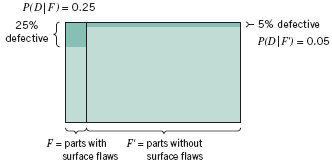Conditional probabilities reflect how the probability of an event alters if we know that some other event has occurred. Consider an example involving manufactured parts as shown in the figure below. In this case, D denotes the event that a part is defective and F denotes the event that a part has a surface flaw. Then, we denote that the probability of D is given, or assuming, that a part already has a surface flaw in this manner: P(D|F). This notation is read as the conditional probability of D given F, and it is interpreted as the probability that a part is defective, given that the part has a surface flaw.

Therefore, the conditional probability of an even B such that A must occur is denoted as P(B│A) and it can be calculated by:
P(B│A) = P (A ∩ B) / P (A) ; P(A) > 0
Example: The probability that a cloudy day will result in the rain is different if you live in Las Vegas than if you live in Seattle.
Properties of conditional probability:
1. Let A and B be events in a sample space S then: P(S│A) = P(A│A) = 1
Proof:
P(S│A) = P (S∩A) / P (A) = P(A) / P(A) = 1
2. Let A, B and C be any events of sample space S such that P(C) ≠ 0, then
P (A U B)│C) = P (A│C) +P (B│C) – P (A ∩ B│F)
And, if A and B are disjoint events then:
P (A U B)│C) = P (A│C) +P (B│C) since, P (A ∩ B)│F) =0
Proof:
P (A U B)│C) = P [ (AUB) ∩ C] / P(C)
= P [ (A ∩ C) U (B ∩ F) ]/P (F)
= {P(A∩ C)+P(B ∩ C) – P(A ∩B ∩F)}/P (F)
= P(A|F) + P(B|F) – P((A ∩B)|F)
3. Let A and B be events in a sample space S then: P (A’│B) = 1 – P P(A│B)
Proof:
P(S│A) = P(A│A) = 1
Then, P(E ∪ E′|F) = 1 because S = E ∪ E′
P(E|F) + P (E′|F) = 1 because E and E′ are disjoint events
Therefore, P(E′|F) = 1 − P(E|F)
Example: If P(E) = 7/13, P(F) = 9/13 and P(E ∩ F) = 4/13, find P(E|F)
We know, P(E│F) = P (E∩F) / P (F) = 4/9
